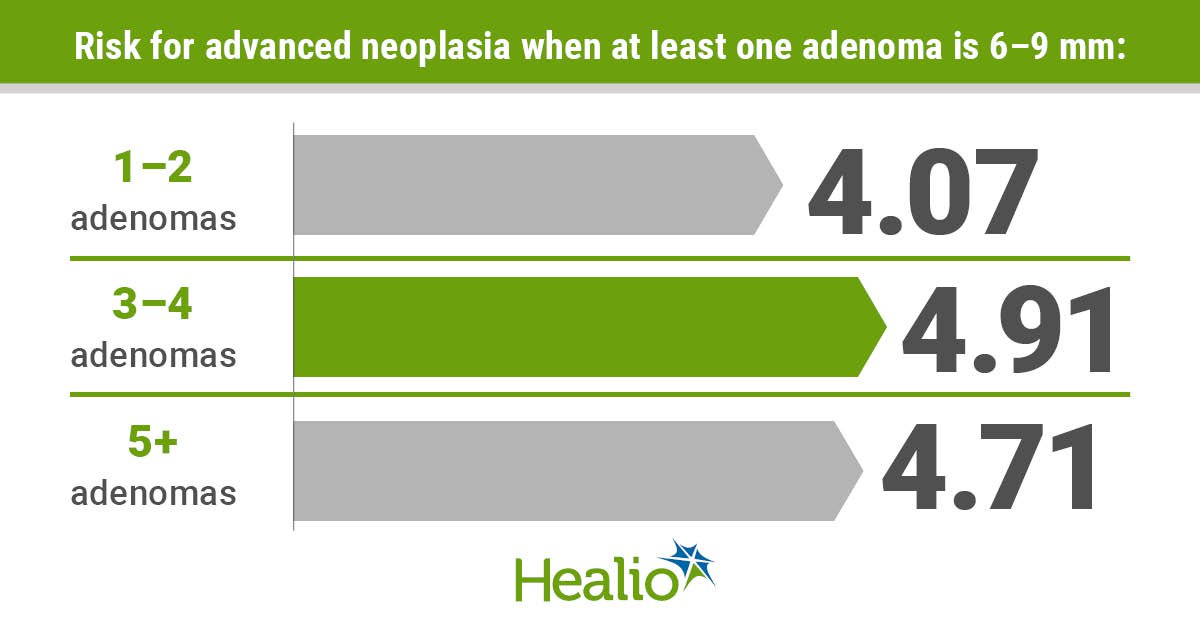Advanced neoplasia risk differs between diminutive, small adenoma at baseline

Patients with small adenomas — between 6 mm and 9 mm in size — at baseline colonoscopy have an elevated risk for advanced neoplasia at follow-up compared with patients who only have diminutive adenomas, according to study results.
Douglas K. Rex, MD, director of endoscopy at Indiana University Hospital, wrote that current guidelines for postpolypectomy surveillance treat small and diminutive (1–5 mm in size) in terms of risk.
“We hypothesized that [small adenomas] could be associated with a greater risk of subsequent development of advanced neoplasia compared with diminutive adenomas,” they wrote. “Indeed, though most previous studies have lumped 1 to 5 mm and 6 to 9 mm adenomas together, some studies have suggested that small adenomas are associated with a higher risk of subsequent advanced neoplasia than are diminutive adenomas.”
Researchers analyzed data from a database of colonoscopies at a single academic center to determine if there was a difference in risk for advanced neoplasia at follow-up. They included patients with baseline colonoscopies with tubular adenomas 1 mm to 9 mm in size with low-grade dysplasia and no advanced adenomas (n = 2,477). They performed follow-up colonoscopies at least 200 days later and assessed for incident advanced neoplasia, defined as cancer, high-grade dysplasia, adenoma 10 mm in size or greater, or with villous elements.

Patients with small adenomas — between 6 mm and 9 mm in size — at baseline colonoscopy have an elevated risk for advanced neoplasia at follow-up compared with patients who only have diminutive adenomas, according to study results.
Rex and colleagues determined that the absolute risk for advanced neoplasia increased from 3.6% in patients with diminutive adenomas to 6.9% in patients with small adenomas (P = .001). They found the highest risk among patients with five or more adenomas, of which at least one was categorized as small (10.4%; P = .006).
When they looked specifically at baseline screening colonoscopies that included at least one small adenoma, investigators found three subgroups of patients categorized by number of lesions were all at increased risk for advanced neoplasia (1–2 adenomas OR = 4.07; 95% CI, 1.5–11.04; 3–4 adenomas OR = 4.91; 95% CI, 1.44–16.75; 5 adenomas OR = 4.71; 95% CI, 1.3–17.05).
“These data indicate that lumping small and diminutive adenomas together in postpolypectomy surveillance guidelines may create risk for some patients with 6 to 9 mm adenomas and/or increase procedure-related costs and risks for patients with 1 to 5 mm adenomas,” Rex and colleagues wrote. “We recommend that additional groups evaluate the impact of small versus diminutive adenomas on the subsequent risk of advanced neoplasia in postpolypectomy surveillance cohorts.” – by Alex Young
Disclosures: Rex reports serving as a consultant for Aries Pharmaceuticals and Olympus Corp.
